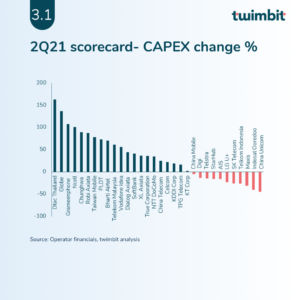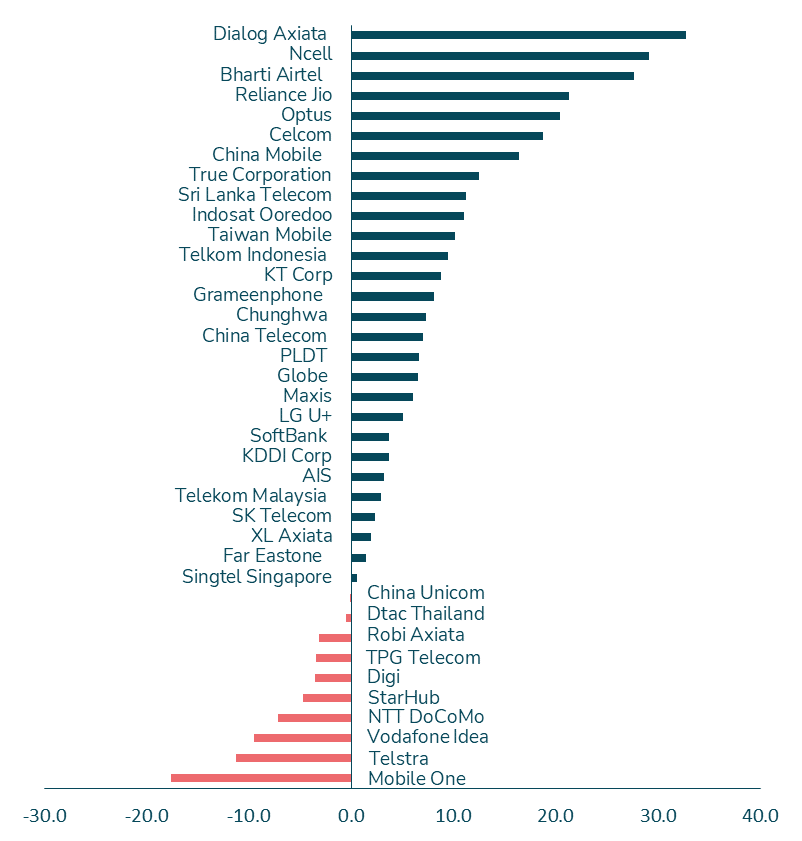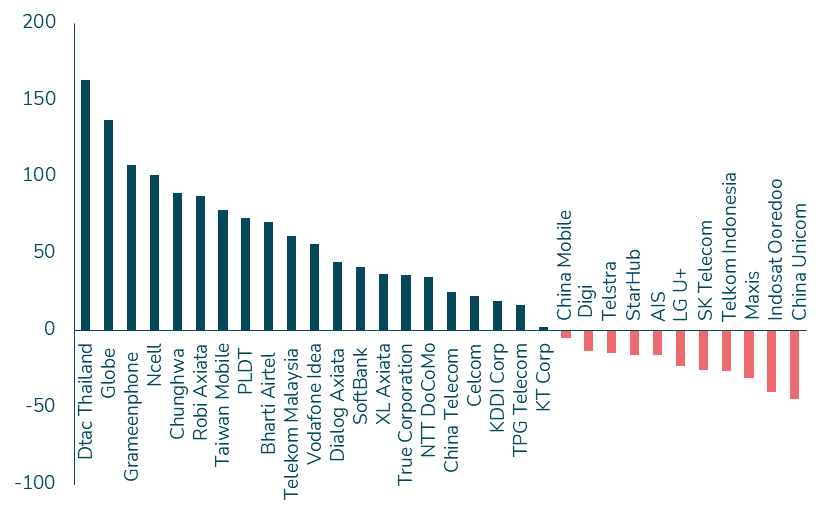There’s amplified joy among APAC telcos in the 2Q2021, 90% of them enjoyed positive revenue growth. In this report, we evaluate and summarise the performances of 39 Asia Pacific telcos for the second quarter (2Q 2021) of the year.
#1 Industry growth of 9.9% in 2Q 2021 compared to just 0.7% last year
- 39 telcos added USD 12.7 billion in revenues in 2Q2021; this number was at a low of USD 912 million at the same time last year. twimbit’s top 5 telcos contributed 75% out of the total net additions i.e., USD 9.6 billion.
- The growth was not limited to year-on-year (Y-o-Y), the APAC operators recorded a 4.4% quarter-on-quarter revenue growth (Q2 2021 vs Q1 2021)
- Dialog Axiata had the most significant growth in both revenue and EBITDA of 24.5% and 32.8%, respectively. The Sri Lankan operator made massive efforts in bringing connectivity to all parts of the country. It added 515 new towers during the pandemic, reaching 4,000 mobile 4G sites, the highest tower count in Sri Lanka. This increase in connectivity resulted in a strong performance across all key segments, and the mobile subscribers reached 16.9 million, up by 12% Y-o-Y
Figure 1: % Revenue change for APAC telcos, 2Q 2021
- The continued momentum in the e-commerce platform Momo has helped Taiwan Mobile achieve wonders in the region. A higher 5G penetration rate complemented the 40.6% growth in Momo. Taiwan Mobile completed one year since the launch of 5G commercial services.
- China Mobile added the most revenues in APAC for 2Q2021, a whopping US$5.5 billion. The operator added 3.6 million new users to its mobile subscriber base while witnessing double-digit growth in all other adjacencies like ‘home’, ‘business’, and ‘new’ markets.
- The SoftBank owned largest Japanese mobile payment app PayPay gained considerable user traction. Payments using the app increased by 1.8 times (Y-o-Y) to 790 million this quarter. Besides this growth, the telco introduced data carry over services and data plans for small needs. These initiatives drove the consumer business up by 11%.
- China Telecom also grew 13.5% for this quarter. A successful implementation of the ‘cloudification and digitalisation’ strategy resulted in a commendable growth.
- Bharti Airtel was successful in increasing its ARPU by 5.7% to USD 2. All the services in the well-diversified portfolio of the telco showed growth. Furthermore, it witnessed the highest ever addition in customers- 285,000 for its home business – during the quarter.
#2 EBITDA growth of 6.8% in 2Q 2021 compared to 4.7% last year
- The average EBITDA margin in the industry was stable at 39%. In 2Q2021, the industry added USD 3.1 billion in earnings (Y-o-Y), which were a billion dollars more than the last time at USD 2.1 billion.
- The Australian operators Telstra and TPG telecom are confident of a turnaround in financial performance in the subsequent quarters. Telstra, for instance, reduced its operating expenditure (OPEX) by 10.2% (Y-o-Y) to circumvent the major decline in fixed revenues. TPG Telecom, on the other side, saved USD 28.1 million on OPEX (Y-o-Y)
- Vodafone Idea (VI) suffered a major setback because of AGR (Adjusted Gross Revenue) dues of USD 8.1 billion, which heavily increased the company’s liabilities. This setback, in turn, created distrust in the minds of the consumers, and the Indian telco has been losing customers. Additionally, Vodafone Plc has ruled out any further equity investment into VI.
- Prepaid revenue for Mobile One in Singapore took a hit – while, its postpaid customers grew by 5% Y-o-Y.
Figure 2: % EBITDA change for APAC telco operators, 2Q 2021
#3 CAPEX spending grew 6.3% in 2Q 2021 compared to 2.9% last year
- 65% of telcos increased their spending in this quarter. The increased data consumption as a result of the pandemic drove higher CAPEX spending among telcos.
- This year, telcos leveraged the higher growth in revenues by spending it in fields like R&D and 5G infrastructure. The tailwind in uplifting customer experience by investing in infrastructure has also ramped up the spending.
- Spending on CAPEX, 2Q 2021- USD 22.2 billion (driven by the growth in data consumption and 5G rollouts) as compared to USD 20.9 billion in 2Q 2020.
- The Chinese and Korean operators took a back seat in their spending. These operators commercially launched 5G way earlier than the other telcos in the region.
Figure 3: % CAPEX change for APAC telco operators, 2Q 2021
#4 The early 5G adopters (China and South Korea) are seeing mobile ARPU uplift
- Early birds in the 5G rollout maintain positive growth in mobile ARPU over the quarter. This is emerging as a consistent trend across the region.
- Singtel group overall achieved ARPU upliftment in 2Q 2021. The adoption of higher 5G ARPU plans, coupled with the continued rise in Optus choice plans, benefitted the Australian telco.
Figure 4: % mobile ARPU change for APAC telco operators, 2Q 2021
#5 China Mobile, Softbank, China Telecom, Taiwan Mobile and Bharti Airtel ace twimbit’s Growth Index
Benchmarking growth of telcos across countries with varying levels of population and economic standing is hard. To recognise the growth leaders, we developed the twimbit Growth Index. It is based on success in two parameters. Both parameters are given equal weightage.
- Absolute change in revenue
- Percentage change in revenue
Figure 5: twimbit’s Top 5 Telcos to ace growth, Q2 2021
| twimbit growth rank | Telco | Country | Absolute change (USD million) | % Change (Y-o-Y) |
| #1 | China Mobile | China | 5,497 | 17.6 |
| #2 | SoftBank | Japan | 1,692 | 15.7 |
| #3 | China Telecom | China | 2,003 | 13.5 |
| #4 | Taiwan Mobile | Taiwan | 255 | 22.6 |
| #5 | Bharti Airtel | India | 245 | 11.1 |
| – | All APAC | – | 12,702 | 9.9 |
| – | Top 5 | – | 9,692 | 16.1 |
- The top 5 telcos grew 16.1% as compared to the average for the 39 telcos which was 9.9%
Check out how the enterprise segment is doing for telcos in the region this year


















